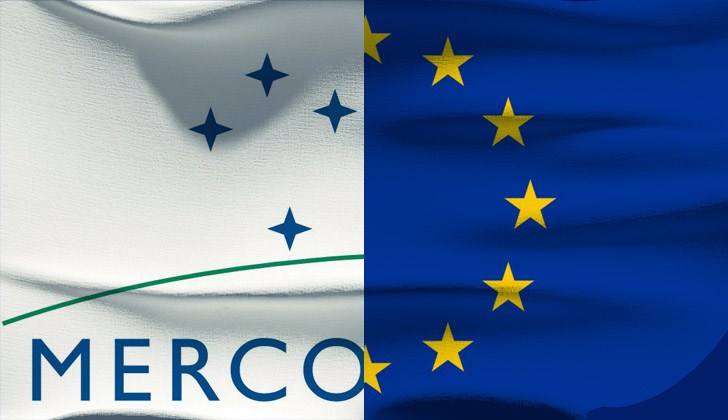 The latest push by the Mercosur countries to conclude a free trade agreement with the European Union has once again fallen flat. The nations’ leaders wanted the agreement to send a clear signal to “the markets” that current economic policy is radically different than it was before and make it abundantly clear that they believe the free market is a panacea for economic and social development in this sub-region of South America. It was a valiant effort, but, once again, they were unable to avoid failure in the negotiations.
The latest push by the Mercosur countries to conclude a free trade agreement with the European Union has once again fallen flat. The nations’ leaders wanted the agreement to send a clear signal to “the markets” that current economic policy is radically different than it was before and make it abundantly clear that they believe the free market is a panacea for economic and social development in this sub-region of South America. It was a valiant effort, but, once again, they were unable to avoid failure in the negotiations.
The first attempts at a free trade agreement between the European Union and Mercosur date back to 1995, when the two blocs signed the Interregional Framework Cooperation Agreement (IFCA). This agreement, which came into force in 1999, was signed when Mexico’s NAFTA had just gone into effect. That same year, FTAA negotiations were launched at the Summit of the Americas in Miami.
European manufacturers and service and tech companies were concerned about their loss of competitiveness in the Americas vis-à-vis the United States. They chose Mercosur—the world’s fifth largest market, to which they are united not only economically, but also culturally—to be a counterweight. The European Union is the number-one source of direct foreign investment and one of the largest export destinations for Mercosur.
This agreement (IFCA) sought to foster bi-regional ties and had three main components: political dialogue, cooperation and commerce. In 2000, it became the foundation for negotiating a trade agreement between the two regional blocs.The agreements came into force at the same time that FTAA negotiations were taking place and the multilateralism of the WTO was weakening.
Despite the fact that tariffs in the European Union were generally low for Mercosur countries, agricultural products were highly protected. Mercosur made its big stand in wagering the EU would liberalize this sector. Meanwhile, the European Union wanted Mercosur to liberalize services and government contracts, to give equal treatment to European investors and increase protections for intellectual property.
But disagreements in these areas led to suspension of negotiations in May 2004. The failure to move ahead with the FTAA at the beginning of that year, which became an outright rupture on the political level during the 2005 Summit of the Americas in Mar del Plata, reduced European concerns regarding U.S. competition in this sub-region. FTAA negotiations broke down for the same fundamental reason that negotiations between Mercosur and the European Union were interrupted: if the United States was unwilling to deal with the issue of domestic assistance and subsidies to their agricultural sector, then services, government contracts, investment and intellectual property were off the table too.
Negotiations remained suspended until 2010, when they were resumed at the initiative of the European Commission in a context of an international financial and economic crisis, fourteen free trade agreements between the United States and other countries in the Americas, stagnating multilateral advances in the World Trade Organization, and China’s increased economic presence in the region. Negotiations with Mercosur resumed during the VI European Union–Latin America and Caribbean Summit in Madrid in May 2010.
But the bid to relaunch negotiations wasn’t free of conflict within the European Union. According to the IDB, “A set of countries led by France, and including Ireland, Greece, Hungary, Austria, Luxembourg, Poland and Finland, introduced a document to the Council of the European Union in which they criticized the European Commission for deciding to resume negotiations without prior debate and without taking into consideration the possible impacts to the European economy, including the agricultural sector. The main European agriculture and livestock organizations endorsed this line of questioning.”1
Despite the harsh reactions internally, the European Commission remained firm in its intent to have a greater presence in Latin America. Not only did they announce the aforementioned resumption of negotiations with Mercosur, but they also signed the Central American Association Agreement, the Economic Partnership Agreement with the Caribbean Community (CARICOM), and a trade agreement with Colombia and Peru. In 2014, Ecuador added its name to that agreement.2
Positions inside Mercosur weren’t uniform, either. The Argentine Government was the most reluctant to continue negotiations in the terms presented, raising the issues of asymmetry between the blocs and the impact on jobs in manufacturing and the local service sector. But the 2015 change of government in Argentina and the rise to power of Michel Temer in Brazil in 2016 accelerated the negotiations.
Negotiators expressed hopes that an agreement could be signed during the 11th Ministerial Conference of the WTO, which took place December 2017 in Buenos Aires. But the Summit came and passed and they still can’t reach an agreement. In almost twenty years of negotiations, and regardless of the various political stripes of the different Latin American governments, the European Union has been unable to strong-arm Mercosur.
The points of contention continue to be basically the same. Mercosur, which has not signed any free trade agreements with another country or economic bloc, has not accepted the European Union’s limited offer to open its agricultural sector, and it has reaffirmed its refusal to open up its manufacturing and service sectors or agree to “WTO-plus” conditions with respect to the aforementioned issues.
No matter how obliging the governments of Mercosur are, they cannot change an obvious reality: the European Union will not modify its common agricultural policy, so the only thing it can offer for Mercosur’s sensitive products (ethanol and beef) is quotas. The Brazilian and Argentine manufacturing sectors will not accept the current terms of the negotiation, either.
At the end of February of this year, Mercosur’s manufacturing centers sent EU trade-agreement negotiators a declaration demanding “transparency” in the negotiations and the terms and conditions, so that sectors that are negatively affected by the agreement can transition and continue to be active in the new context. They also demanded a balanced agreement recognizing differences between the two sides in terms of development. In March of this year at a meeting of negotiators in Asuncion, the presidents of the manufacturing centers of Argentina, Brazil, Paraguay and Uruguay also demanded the inclusion of an “industrial development clause” and to maintain various protection instruments for production and employment that are “fundamental for the current and future functioning of Mercosur.”3
Representatives of the labor movement in Mercosur and the European Union (Coordinator of the Southern Cone Trade Unions [CCSCS, in Spanish] and the European Trade Union Confederation [ETUC]) handed the chief negotiators a letter in which they clearly expressed the reasons behind their opposition to the agreement: “It is not an authentic agreement of fair and balanced partnership that is being created, but a trade agreement that harms the less developed countries on both sides of the Atlantic in their national industry, and in fostering production and decent jobs.”
Despite the lack of information and transparency, voices of the affected sectors from within both regional blocs have protested the terms and academics and civil society have issued warnings of the implications. The recent economic crisis in Argentina has also undermined negotiations. Economic liberalization policies are clearly not delivering the hoped-for results, and Argentina now faces increasing fiscal and trade deficits, runaway inflation, devaluation and capital flight, forcing the Central Bank to raise interest rates from 27.25% to 40% in one week. The economic landscape is not much better in Brazil, where presidential elections will be held in October.
Reality seems to indicate that the negotiations should be set aside once more. Officials should first consider what economic and productive profile they want their countries to have in the current environment.
Translation for the Americas Program: Slava Faybysh
 Ariela Ruiz Caro is an economist from the Humboldt University of Berlin with a master’s degree in Economic Integration processes from the University of Buenos Aires. International consultant on issues of trade, integration and natural resources in ECLAC, Latin American Economic System (SELA), Institute for the Integration of Latin America and the Caribbean (INTAL), among others. She has been an official of the Andean Community between 1985 and 1994 and advisor to the Commission of Permanent Representatives of MERCOSUR between 2006 and 2008. She is a columnist for the Americas Program.
Ariela Ruiz Caro is an economist from the Humboldt University of Berlin with a master’s degree in Economic Integration processes from the University of Buenos Aires. International consultant on issues of trade, integration and natural resources in ECLAC, Latin American Economic System (SELA), Institute for the Integration of Latin America and the Caribbean (INTAL), among others. She has been an official of the Andean Community between 1985 and 1994 and advisor to the Commission of Permanent Representatives of MERCOSUR between 2006 and 2008. She is a columnist for the Americas Program.
NOTES
1 Makuc. Duhalde, Rozemberg, La Negociación MERCOSUR-Unión Europea a Veinte Años del Acuerdo Marco de Cooperación: Quo Vadis?, The Institute for the Integration of Latin America and the Caribbean, IDB, August 2015
2 Partnership Agreements or Trade Agreements with the European Union have the same structure as the so-called trade promotion agreements between Latin American countries and the United States. The official names of these agreements are different than what they were during the negotiation process: free trade agreements.
3 Della Croce Claudio, Otro revés para TLC entre el Mercosur y la Unión Europea, March 7, 2018, NODAL https://www.nodal.am/2018/03/reves-tlc-mercosur-la-union-europea-claudio-della-croce/
4 Ibid



